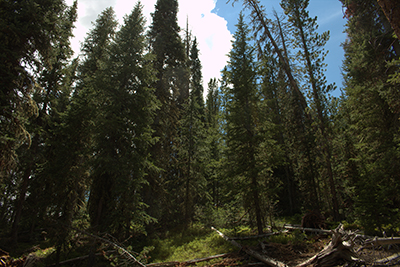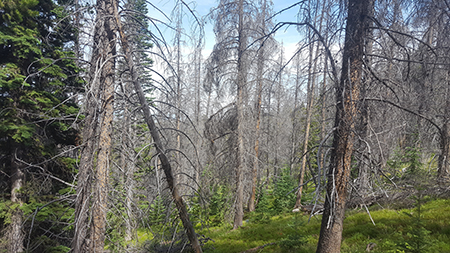
Key projected climate change impacts that the project team considered for the Colorado State Forest include:
- Altered seasonality: The CO State Forest is experiencing warmer temperatures, particularly hotter and drier summers
- Longer growing seasons: Winters are becoming shorter and milder, with less precipitation falling as snow and earlier snowmelt in the spring. This can cause vegetation to use up the soil moisture earlier and increase the risk of mid-late season drought
- Uncertain changing precipitation patterns: Projections indicate potentially less snow during the winter and/or less rain during the spring/summer that could impact seedling regeneration and survival
- Elevated drought risk: Forest vegetation may face increased risk of moisture deficit and drought during the growing season
- Increased potential for wildfires: Warmer and drier weather during the growing season may create conditions more suitable for uncharacteristic fires, decrease the fire return interval for high-elevation forests, and lengthen the fire season. Decreased winter precipitation and early spring snowmelt may also contribute to larger and more severe fires because of the diminished water stores in the soil that contribute to water stress
- Increased risk of insect pests and forest pathogens: Several native pests, including spruce bark beetle, spruce budworm, mountain pine beetle, and dwarf mistletoe currently affect forests across the region
- Increased disturbance and tree mortality: Many interacting stressors (weather, forests pests, invasive plants, deer herbivory, etc.) are already causing significant mortality in parts of the state and leading to changes in forest condition and composition
CHALLENGES

Climate change will present challenges and opportunities for accomplishing the management objectives of the Colorado State Forest, including:
- Fires are starting to change vegetation dynamics:
- Tree regeneration post fire can be difficult for spruce-fir forests due to potentially drier or warmer conditions
- Wildfire, insects/disease, and drought are some of the most damaging disturbances to State Forest. While spruce-fir forests have some resistance to the damage, the intensity and combination of disturbances are an important indicator for the rate of tree mortality rate and ecosystem impact
- Bark beetles are capitalizing on changes in climate: Bark beetles can travel and adjust to new conditions better than forests can. Tree cohorts (generations) establish and grow at much longer intervals than bark beetles do, so they adjust to changes at much slower rates. Since we are seeing climate changes at an unusually fast pace, tree species are having a harder time keeping pace than the beetles. Species such as spruce beetles and mountain pine beetles may be able to do more damage than we are seeing currently
- Warmer temperatures allow the beetle lifecycle to happen in a year or less-producing at least on generation a year
- Native southern species of beetles are limited by the cold temperatures at these higher elevations. Warming conditions from climate may allow southern species to move northward or to higher elevations
- Drought makes forests susceptible to beetle outbreak: Since trees are already making trade-offs with water use, it takes fewer beetles to overwhelm the tree’s defenses
- Reduced snowpack is expected, leading to drier soils, reduced streamflow, and earlier or more frequent droughts
- Spruce-fir forests require high moisture to regenerate, especially in warmer temperatures
- Changes in tree species habitat. The combination of warmer temperatures, drought, and frequent disturbance could shift the site-specific, suitable habitat for tree species across the State Forest
- Tree species that are better suited to a cooler climate may move to a higher elevation to follow the cooler temperatures. Likewise, species suited to warmer climate may move higher as greater elevations warm past their usual temperatures
- These changes in species composition are likely to affect wildlife habitat and ranges
- Spruce fir forests may see more disturbance and mortality:
- Currently in terms of wildfires, spruce fir forests are a climate limited system, meaning that moisture levels determine the fire regime rather than the fuel characteristics
- The fire regime may change to more frequent, intense, and severe fires due to dry fuels from reduced precipitation and slow decomposition rates. These fires may also be larger, making regeneration of spruce-fir forests more difficult due to the limited distance these wind-dispersed seeds can travel
OPPORTUNITIES

- Increased range: Tree species that are better suited to a warmer climate and found in low density on the State Forest Psuedotsuga menziesii (Douglas-fir), aspen, and Pinus ponderosa (ponderosa pine)), could expand their range.
- Assisted migration may also be an option to artificially increase or shift species ranges ahead of climate change to provide a viable seed source when these trees are ready to reproduce in a warmer climate
- Assisted migration has three separate sub-definitions:
- Assisted population migration moves seeds of a species to a new location within its historical range
- Assisted range expansion moves some seed sources or populations to sites just outside of the historical range of that species
- Assisted species migration involves moving seed sources or populations farther outside the historical and seed dispersal range
- Species respond individually: We may not lose all species at once and it is possible to find ones to replace the niches of the shifted species
- It will not be an immediate change. There is time to plan and work on the ecosystem transition
- Fire promotes species diversity: Fires can facilitate regeneration of a diverse mix of species post-fire. This creates a more resilient system due to more diverse sets of genes in the ecosystem that react to fires differently. This way there are many different strategies to deal with disturbance and a variety of species can excel depending on the severity and intensity of the disturbances
- Droughts hinder fungi growth: Fungi can be brought in by mountain pine beetles and begin to water stress the tree. If there is already a drought, the fungus has a much harder time taking hold
- Drought makes the tree’s leaves tougher and less palatable to pests


